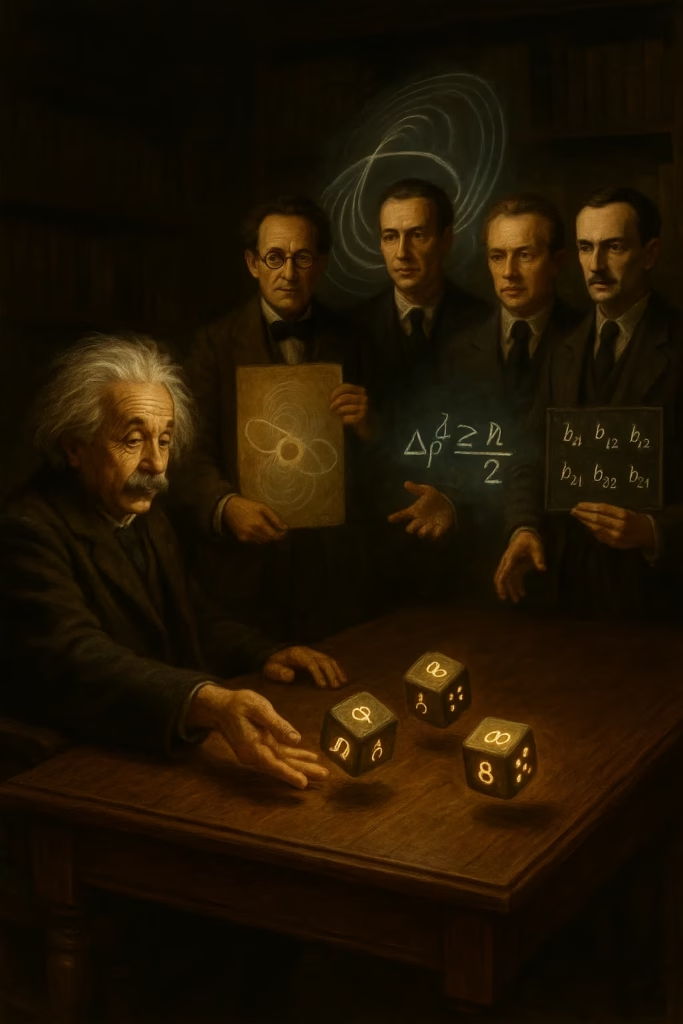Albert Einstein began the era of quantum physics with his work on the photoelectric effect and theory of relativity, only to become its most famous critic a decade later. This is the story of how light became the key to understanding the deepest secrets of the quantum world – a world where particles become waves, waves become particles, and reality becomes a matter of probability.
Einstein’s Revolution: Photons That Changed Everything
Einstein introduced the photon as a particle with no rest mass that always moves at the speed of light. This particle carries energy and momentum, and obeys the laws of special relativity. Yet, this elegant theory couldn’t explain everything: how can individual photons create interference patterns in the double-slit experiment? How can a single particle “interfere with itself”?
The answer lay in the fact that photons, like all other particles of the micro-world, follow different rules – the rules of quantum mechanics.
De Broglie: The Bold Hypothesis That Connected Two Realities
Louis de Broglie proposed a brilliantly simple idea: if light that behaves as a wave can have particle properties, then particles of matter (such as electrons) can also have wave properties. This hypothesis was quickly confirmed by experiments with electrons that, like photons, created interference patterns. Duality wasn’t just a property of light – it was a universal rule of the entire quantum world.
Schrödinger: The Mathematician Who Turned Waves into Equations
Erwin Schrödinger transformed de Broglie’s idea into mathematical language. His famous Schrödinger equation describes how a particle’s “wave function” changes over time. These waves aren’t like those on water – they cannot be directly detected. Instead, the square of the wave function’s amplitude gives the probability of finding the particle at a specific location. Light and matter were no longer deterministic – they became governed by probability laws.
Heisenberg: The Principle That Set Limits to Knowledge
Werner Heisenberg added an even deeper dimension to this new world. His uncertainty principle states that we cannot simultaneously know both the position and momentum of a particle with perfect accuracy. The more precisely we measure one quantity, the more uncertain we become about the other. This wasn’t a limitation of our instruments – it was a fundamental boundary of nature itself.
Einstein Against the Quantum World: The Fight for Determinism
Einstein fiercely opposed this new order. His famous quote “God does not play dice” became a symbol of resistance against the idea that the world at its deepest level is determined by probability. Although his criticism sparked important debates, experiments consistently confirmed quantum predictions. Paradoxically, Einstein’s challenges strengthened quantum mechanics by forcing it to become even more precise.
Dirac: The Man Who Unified Quantum Mechanics and Relativity
The final step in this epochal revolution was brought by Paul Dirac. While Schrödinger’s equation wasn’t relativistic, Dirac succeeded in unifying quantum mechanics with Einstein’s theory of relativity through his famous Dirac equation. This equation is a masterpiece of mathematical elegance – it’s linear and simpler to solve than the Schrödinger equation.
Dirac introduced a revolutionary concept: spin. Spin is an intrinsic quantum-mechanical property of all elementary particles, but it’s not a classical rotation as the name might suggest. It’s a fundamental property that describes how particles “feel” magnetic fields. Dirac described spin using special mathematical objects called spinors and Dirac matrices.
His equation not only described electrons but also predicted the existence of the positron – the first example of antimatter. This discovery opened a completely new chapter in physics and showed how mathematical elegance can lead to profound physical truths.
Journey into the Unknown: What Does the Future Hold?
Quantum mechanics has given us an incredibly powerful framework for understanding light and matter, but it has also opened new questions:
- What exactly is a “wave function”?
- Why does measurement “collapse” the wave function?
- Is there a deeper reality beneath quantum probability?
In the next post, we will continue our journey with Richard Feynman and his revolutionary approach that will offer us a completely new way of thinking about light and particle interactions.


Leave a Reply to drover sointeru Cancel reply